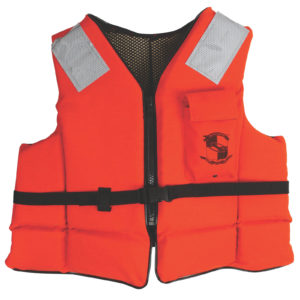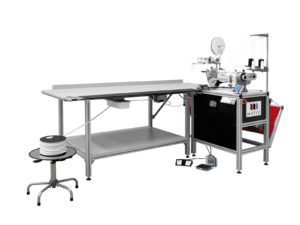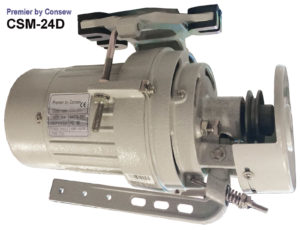
Sewn or sealed, automation is trending as U.S. companies strive to increase efficiency and decrease costs.
The art of sewing textiles is lacking in U.S. manufacturing as lower-cost labor in Asia has helped meet consumer demands for competitive retail prices. But automation technology is slowly advancing, helping companies bring production costs down while keeping quality up.
In 2007, when The Coleman Co. Inc. assumed the operations and control of Stearns Mfg., producer of personal flotation devices, it followed the outsourcing trend and started making most of its recreational products in Asia to stay price competitive on store shelves. The Sauk Rapids, Minn.-based Stearns plant went down to a skeleton crew, making PFDs for the U.S. Department of Defense and industrial customers.
Four years later, the company set out to bring product manufacturing back to central Minnesota by automating its sewing process. “Prior to that, everything was made with single-needle stitch sewing machines with highly skilled sewers. When you’re paying a competitive wage in the U.S., you can’t compete with labor in Asia, and retail customers were demanding lower prices,” says Jeff Schmitt, Coleman’s vice president of U.S. operations and global procurement, in Golden, Colo.
The company reached out to others in the industry who were making Berry-compliant products (which by law must be made in the USA), industrial sewing machine manufacturers and other companies involved in the cut-and-sew industry. “Everyone we talked to was supportive but cautioned us that we were definitely taking a contrarian approach with our manufacturing strategy. Further, there was not a lot of capacity to build sewing automation tooling left in the USA, as the industry had effectively moved out of the USA,” says Schmitt.
Sew your own way
Coleman set out to develop an automated sewing system that could control the fabric while moving at high enough rates of speed to attain a production level that could hold prices down. The company went through several generations of tooling, before settling on what is being used today on the production floor.
“Basically we purchased standard off-the-shelf automated industrial sewing machines and built customized tooling and workstations that eliminated as much labor content as possible,” says Schmitt. “Tooling development and workstation development was an interactive process. Every design brought into the business taught the team something that could be incorporated into the next design. Coleman has been able to grow our annual output to about 3.5 million pieces and our workforce has grown from 60 to 275 today. By taking so much time out of the production process, we’ve been able to bring a large volume of products back.”

It’s easier today for Coleman to make the tools in-house to control the tooling and workstation designs, notes Schmitt. The advantage is a more consistent process that yields high levels of quality and reduces scrap costs. A UL inspector is at the facility three days a week, making the certification process more efficient.
“We take advantage of highly programmable sewing, smaller footprint and lower costs by developing our own technology that works in unison with our fixturing,” says Schmitt. “We are a light industrial manufacturer with highly skilled workers. We may have someone make a child Puddle Jumper® today and an adult recreational PFD tomorrow, and do that with ease.”
The company also recently made a sizeable investment in direct printing on fabric, allowing it to print fabrics “on the fly” right onto a cutter and automated sewing machines. “That’s going to be the future—highly flexible, highly customizable manufacturing that is direct to consumer,” says Schmitt.
Slow steps to automation
The march toward sewing automation is a long, slow one. The cost is prohibitive for some companies. And many in the industry may still rely on clutch motors to drive their sewing machines, which require experienced machine operators.

“In the IFAI industry, we deal with a lot of smaller shops, less than 50 machines,” says Doug Glenn, vice president of sales at Consew Consolidated Sewing Machine Corp. in Carlstadt, N.J. “Typically they get into some automation, but very little. I’m working with a number of companies that produce parachutes, and they look for automation in certain areas, such as metering webbing then hot-cut, indexing and folding material in different angles, and then double-needle stitching while inserting a metal ring and applying hook and loop, all produced with one machine without a sewing machine operator. This type of machine costs around $50,000.”
Basic machines can start at $500 and can increase exponentially with various automated features. It can easily jump to six figures for machines that cut by computer, employ material handling robotics or assembling, and package automatically without human assistance.
Glenn says companies can step up to automation by adding simple, user-friendly innovations. For very little money, a company can replace clutch motors with an electric servo motor to increase efficiency while decreasing noise and energy use. Also, a custom binder or folder will increase production and improve the appearance of the seam.
“What used to be $1,000 is now $100 and you can put it on yourself,” says Glenn. “You have the ability with this motor to change your speed electronically without physically changing the pulley. You can mount a synchronizer on the hand wheel to control the needle position up and down.”
Sewing machines can be enhanced with a knuckle (reverse) switch or automatic backtack button, which puts the reverse button close to the needle. A full function machine features automatic reverse, program stitch counting, trim threads at the end of the cycle, automatic pressure foot lift and needle positioning. These machines range from two to four times the cost of a standard machine, according to Glenn.

Apparel industry gets a boost
SoftWear Automation Inc. has developed a low-cost, lightweight robot called LOWRY designed to manipulate fabric and garment parts throughout the automated sewing operation. The robot can connect to manufacturers’ existing sewing machines and equipment to take advantage of the automation it provides. Company CEO K.P. Reddy says it has the potential to transform today’s labor-intensive sewn products manufacturing plant into a high-tech production facility. It reduces cost of production, produces higher-quality sewn products, churns out smaller production lots, provides an increased degree of customization and offers faster turnaround times.
“The apparel and home goods industries will benefit the most from our technologies,” says Reddy. “Retail will also benefit from being able to have a better optimized inventory. Instead of guessing what the market will want and then having to buy and store merchandise, SoftWear’s technology allows retailers to meet consumers’ specific demands in a real-time environment.”
The sewing industry, like many other industries, is moving toward consumers’ desire to have their products produced closer to where they live, he adds. “Today’s consumers care about the story behind the product, where it comes from, how it was made.”
While the custom-tailored apparel market and mass production market will always be around, Reddy sees tremendous growth and opportunity in the middle-tier mass customization segment. “It will grow rapidly in the near future, thanks, in part, to technologies like ours. SoftWear’s robots are essentially 3-D printers for apparel. They will facilitate the rapid growth of this market by greatly reducing the cost and complexity of custom apparel design and manufacturing.”
Increased efficiency
The sewing industry is looking for anything that gets them away from a labor base, notes James Herstein, U.S. sales manager for Matic S.A., a Spanish manufacturer of textile-based finishing solutions including impulse welding and automated sewing machines and accessories. “How do you keep your costs down unless you keep moving from one country with cheaper labor to another? It’s a universal problem.”
Herstein says automation in the welding industry is improving efficiencies for manufacturers and reducing the amount of institutional knowledge needed to do the jobs. An automated machine will do the folding and the weld at the same time on an awning, for example, which has panel welds, hem welds and a pocket. The same is true for impulse welding used for the interior shade market where a lot of different pocket sizes can now be controlled automatically by computerized memory.
“You’re less reliant on skilled laborers and more reliant on the machines. It makes the company faster and more efficient,” says Herstein. “I can have someone up and running (on a machine) in 10 minutes, so if an operator is sick or on vacation, you’re not stuck in a lurch because you need years of experience. That has been beneficial to the manufacturing process.”
Welding machines may do some customized things for specific solutions, but the nuts and bolts are the same. The only thing you need to change is the size of the bar. The trend now is for bigger machines across the board because customers are looking for bigger solutions, adds Herstein. The sun protection market may have machines with a 3-to-4-foot bar. Matic now produces one that is just under 20 feet. Heat and glue welding machines can go up to about 40 feet and are used for pergolas and outdoor shading structures.

Same technology, different growth
Companies looking to onshore are discovering that automation is critical in making their products, says Jeff Sponseller, executive vice president of Miller Weldmaster Corp. in Navarre, Ohio. While there are not a lot of new types of welding technology being developed, new applications are being used. Automating the process for moving product into the welding area is a new area of growth for a lot of companies.
“With the trend to bring more jobs back to the United States, we are experiencing more automation of products. The welding of the product actually stays the same. However, how products are moved into the welding area, how the weld is applied and then moved out of the welding area is something we are seeing as a trend. If a manufacturer can reduce labor and increase production capabilities, he or she can reduce the cost of producing the product, and thus bring jobs back to the states.”
Welding manufacturers are seeing new markets for welding unique and different products together. “We see welding not only in the industrial fabrics industry, but in filtration, packaging and the auto industry,” Sponseller adds.
Welding is gaining a lot of steam for thermoplastics, says Ken Huber, product specialist at Leister Technologies LLC in Itasca, Ill. Thermoplastic materials allow for a seam that is 100 percent air and waterproof. The process is achieved by combining heat in the form of hot air, pressure and speed in order to bond the two materials together.
Leister manufactures hot air, hot wedge and laser welding machines. The materials that weld best are PE, PP, PVC and urethane-coated fabrics, says Huber. Markets currently using hot air include roofing, apparel, environmental, signs, tarps, covers and the military.
Diode laser welders are also making inroads into the textile and fabric industry. Laser welding fabrics requires intimate contact between the layers to be assembled, and it can produce strong seams without piercing the materials. Therefore, it has the capability of producing strong watertight, and possibly air-tight seals, which makes it desirable for use in a number of applications such as clothing, tarpaulins and inflatable rafts, says Huber.
As automation technology advances in both sewing and sealing, manufacturers can be assured that a less skill-based labor force and more efficient production process will impact costs and workforce challenges.
Barb Ernster is a freelance writer based in Fridley, Minn.

Common types of welding
The type of welding technology applies to the application itself, but you will find welding in most of the industries IFAI serves.
RF (Radio Frequency)
Used for thick, heavy, vinyl products, such as large tents, stadium roofs and the truck industry. Material is welded from the inside out using high-powered localized RF energy.
Heat /glue
Hot glue and rollers bond materials together. Used for products made with non-plasticized material, such as awnings and acrylics.
Ultrasonic welding
Similar to heat/glue, but lays out a tape and uses a heat method and rollers to bond. Used for different thermoplastics, primarily thinner materials, nonwovens, thin plastics and high-end outdoor weather gear.
Hot wedge/hot air
A heat application used for large-scale projects that have multiple seam types and widths. It welds thermoplastic materials, including PVC, polyurethane, polypropylene, polyethylene and nonwovens. Also used for outdoor products requiring a watertight or waterproof seam, or required to hold air.
Impulse welding
Relies on two electrodes that send power to heat the fabric and bond. It welds from the outside in, and is suitable for applications like the shade market. This technology welds a wide array of products that use thinner materials and 2-D construction.

Photo: SoftWear Automation Inc.
Fabric innovations create challenges, new markets
The apparel market is benefiting from innovation in the materials sciences. New technology is being developed around materials that are more breathable, wrinkle-free and durable, says K.P. Reddy, CEO of SoftWear Automation Inc. The company recently met with a company in MIT that is buying used coffee grounds from Starbucks and creating thread out of it. The thread is woven into socks so they are odor-free.
Companies are also working to extend the use of many popular natural fabrics. New processes are being developed to leverage wool in T-shirts and other athletic garments because it wicks very well.
“I don’t think any of these new materials makes sewing easier. In fact, it is making it harder because the wide variability of products and materials requires a high amount of configurability on the manufacturing side. These new fabrics sometimes drive how you tool and process things in a factory,” says Reddy. “They all have to be handled a little differently. However, SoftWear’s products are less affected by differences in materials because our vision and material manipulation systems work at the individual thread level.”
Within its mass-produced PFD line, The Coleman Co. Inc. has more than 100 different SKUs moving through the factory at any given time. Its ability to retool its fixtures to accommodate custom designs and new fabrics has helped the company become more flexible to meet consumer demands. “Over the past couple years we’ve moved to new fabrics that are more comfortable for the user. The challenge is the material moves around a lot easier and is more difficult to control during the sewing process,” says Jeff Schmitt, Coleman’s vice president of U.S. operations and global procurement. “We’ve had to overcome this with a series of revisions in our tooling and fixtures, but we have a solution now that works very well.”
Coleman gets about 60 percent of its materials and components from U.S. sources, including its thread which has to be UL-certified and U.S. Coast Guard-approved for strength and colorfastness. The company has not yet been able to get the required specification of UL-certified, CG-approved polyester in the U.S.
James Herstein, U.S. sales manager for Matic S.A., notes that some of the new eco-materials have required adjustments to weld them properly. Phifer Inc., for example, has a new eco-material with bio-based plasticizers for sun protection. “Getting the right settings on the welder has been a little more difficult because it’s such a different material from a standard PVC-coated material. It took longer, but is not impossible.”
 TEXTILES.ORG
TEXTILES.ORG


